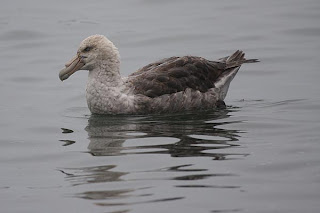 |
| Southern Giant Petrel - Photo by Paul Gale |
Class : Aves
Order : Procellariiformes
Family : Procellariidae
Genus : Macronectes
Species : M. giganteus
Wingspan : 78in (200cm)
IUCN Status : Least Concern
This particular species of bird goes by many names : the Southern Giant Petrel, Stinker, Stinkpot, Giant Fulmar, and "Bone-shaker" among them. Why Stinker and Stinkpot though? When these birds feel threatened they can accurately spit blobs of regurgitated food and oil at their attackers. Stinky indeed!
Southern Giant Petrels can be found in the Southern Hemisphere, breeding near Antarctica and its nearby islands. They are large seabirds, rivaling the albatrosses for size, though then have slimmer wings and much, much larger beaks. Petrels often skim over the water, and are able to take off and land in it. These abilities are the source of the name "Petrel," which comes from St. Peter, the Apostle who walked on water.
 |
| Southern Giant Petrel - Photo by Paul Gale |
Southern Giant Petrels mate in October and November, and each pair only lays one egg at a time, which takes over two months to incubate. Both parents care for the egg and the chick until it fledges around March and goes off on its own. Young Petrels will fly about on a long migration for several years, but after about six or seven they return to the place that they were born in order to breed.
Comments
Post a Comment